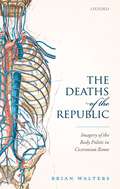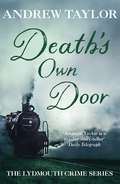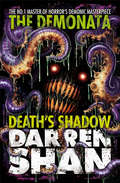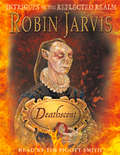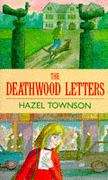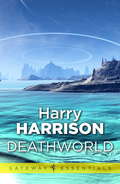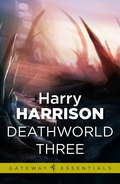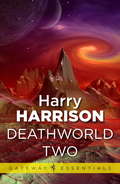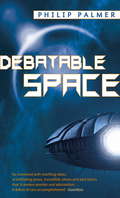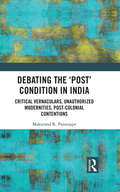- Table View
- List View
The Deaths of the Republic: Imagery of the Body Politic in Ciceronian Rome
by Brian WaltersThat the Roman republic died is a commonplace often repeated. In extant literature, the notion is first given form in the works of the orator Cicero (106-43 BCE) and his contemporaries, though the scattered fragments of orators and historians from the earlier republic suggest that the idea was hardly new. In speeches, letters, philosophical tracts, poems, and histories, Cicero and his peers obsessed over the illnesses, disfigurements, and deaths that were imagined to have beset their body politic, portraying rivals as horrific diseases or accusing opponents of butchering and even murdering the state. Body-political imagery had long enjoyed popularity among Greek authors, but these earlier images appear muted in comparison and it is only in the republic that the body first becomes fully articulated as a means for imagining the political community. In the works of republican authors is found a state endowed with nervi, blood, breath, limbs, and organs; a body beaten, wounded, disfigured, and infected; one with scars, hopes, desires, and fears; that can die, be killed, or kill in turn. Such images have often been discussed in isolation, yet this is the first book to offer a sustained examination of republican imagery of the body politic, with particular emphasis on the use of bodily-political images as tools of persuasion and the impact they exerted on the politics of Rome in the first century BCE.
The Deaths of the Republic: Imagery of the Body Politic in Ciceronian Rome
by Brian WaltersThat the Roman republic died is a commonplace often repeated. In extant literature, the notion is first given form in the works of the orator Cicero (106-43 BCE) and his contemporaries, though the scattered fragments of orators and historians from the earlier republic suggest that the idea was hardly new. In speeches, letters, philosophical tracts, poems, and histories, Cicero and his peers obsessed over the illnesses, disfigurements, and deaths that were imagined to have beset their body politic, portraying rivals as horrific diseases or accusing opponents of butchering and even murdering the state. Body-political imagery had long enjoyed popularity among Greek authors, but these earlier images appear muted in comparison and it is only in the republic that the body first becomes fully articulated as a means for imagining the political community. In the works of republican authors is found a state endowed with nervi, blood, breath, limbs, and organs; a body beaten, wounded, disfigured, and infected; one with scars, hopes, desires, and fears; that can die, be killed, or kill in turn. Such images have often been discussed in isolation, yet this is the first book to offer a sustained examination of republican imagery of the body politic, with particular emphasis on the use of bodily-political images as tools of persuasion and the impact they exerted on the politics of Rome in the first century BCE.
Death's Own Door: The Lydmouth Crime Series Book 6 (Lydmouth Crime Series #6)
by Andrew Taylor'Andrew Taylor is a master story-teller' Daily Telegraph From the No.1 bestselling author of The Ashes of London and The Fire Court, this is the sixth instalment in the acclaimed Lydmouth seriesWhen the body of Rufus Moorcroft, a middle-aged widower with a distinguished war record, is found in his summerhouse, the verdict is suicide. But both reporter Jill Francis and her lover, Detective Richard Thornhill, approaching the case from different angles, discover there's more to it than that. The key to the mystery stretches back to a highly-charged summer before the war, and back to another death. A local asylum plays a part, as do a moderately famous artist and his wife; Superintendent Williamson, now retired and loathing it; Councillor Bernie Broadbent - a man with more pies than fingers to put in them; a Cambridge don; an aristocratic unmarried mother, now gleefully drawing her old-age pension; and - to Thornhill's surprise and growing horror - his own wife, Edith.'An excellent writer. He plots with care and intelligence and the solution to the mystery is satisfyingly chilling' The Times'The most under-rated crime writer in Britain today' Val McDermid 'There is no denying Taylor's talent, his prose exudes a quality uncommon among his contemporaries' Time Out
Death’s Shadow (The Demonata #7)
by Darren ShanFresh hell from the Demonata – you can’t cheat death…
Deathscent: Intrigues of the Reflected Realm (Intrigues Of The Reflected Realm Ser. #Vol. 1)
by Robin JarvisThe first enstalment of an exciting NEW series from the author of The Wyrd Museum Trilogy and The Deptford Mice.
Deathwing Over Veynaa (Gateway Essentials #Bk. 2)
by Douglas HillIt was a sight he had seen once before in reality, and a thousand times since in nightmare. A planet surrounded by a glowing, pulsating, golden nimbus of lethal radiation...Co ninuing his search for the evil Galactic Warlord, Keill Randor, the Last Legionary, joins a rebellion on the Cluster and meets a powerful mutant who may be part of Deathwing, the Warlord's deadly army.Keill and Glr, his alien friend, must fight this enemy and escape the lethal forces ranged against them. But can they also save the planet Veynaa from total annihilation?
Deathwish: Cal Leandros Book 4 (A Cal Leandros Novel #4)
by Rob ThurmanThe fourth book in the Cal Leandros series that began with Nightlife, Deathwish is clever, ironic and hugely entertaining urban fantasy in the vein of Jim Butcher by the New York Times bestselling author, Rob Thurman.'How I felt the mental stirrings of a bloodthirsty heritage when I passed through the gray light wasn't my favourite topic . . . the Auphe nature wasn't mine. I wouldn't let it be. And if I said that to myself over and over and sprinkled around enough frigging fairy dust, maybe it would be true.'Half-human Cal Leandros and his brother, Niko, are barely getting by with their preternatural detective agency when the vampire Seamus hires them. He's being followed, and he wants to know by whom. But the Leandros brothers have to do more than they had planned when Seamus turns up dead (or un-undead).Worse still is the return of Cal's nightmarish family, the Auphe. The last time Cal and Niko faced them, the Auphe were almost wiped out. Now they want revenge. Cal know that before the Auphe get to him, they will try to destroy everything and everyone he holds dear. Because for the Auphe, Cal's pain is a pleasure.And they're feeling good.A dark contemporary fantasy with a humorous edge, Rob Thurman's Deathwish should not be missed.Praise for Rob Thurman:'Supernatural elements put this in the company of Jim Butcher and Charlaine Harris' SFRevu'A roaring rollercoaster of a read . . . it'll take your breath away' Simon R. GreenRob Thurman lives in Indiana, land of rolling hills and cows. Lots and lots of cows. Nightlife, Moonshine and Madhouse, the previous novels in the Cal Leandros series, are also published by Penguin. Visit Rob at www.robthurman.net.
The Deathwood Letters
by Hazel TownsonA story told entirely in letter form, by the author of the Lenny and Jake series. When Damian Drake rescues his dog from a well and gets his name into the papers, he hears from a girl he has never met. They begin a correspondence which develops a sinister element and a dramatic climax.
Deathworld: Deathworld Book 1 (Gateway Essentials #Bk. 1)
by Harry HarrisonThe planet was called Pyrrus, a strange place where all the beasts, plants and natural elements were designed for one specific purpose: to destroy man.The settlers there were supermen, twice as strong as ordinary men and with milli-second reflexes. They had to be. For their business was murder.It was up to Jason dinAlt, interplanetary gambler, to discover why Pyrrus had become so hostile during man's brief habitation.
Deathworld Three: Deathworld Book 3 (Gateway Essentials #Bk. 3)
by Harry HarrisonThe planet was called Felicity. The name was a joke, except for those compelled to settle there. Inhabiting it were beings bred for thousands of years for a single purpose: to attack and kill.Jason knew this. But he also knew the planet on which he lived was moving towards certain disaster. And Felicity was the only spot in the universe where he and his companions could survive. He thought he had worked out the perfect plan. But what awaited him on Felicity went far beyond his wildest imagining.
Deathworld Two: Deathworld Book 2 (Gateway Essentials #Bk. 2)
by Harry HarrisonThe planet was unknown¿ a savagely primitive place where every man had to kill every other man - or live as a slave.The inhabitants lived in the early Bronze Age one minute, and in the early Machine Age the next. Technology had degenerated into a number of mysteries jealously guarded by separate brotherhoods.But Jason dinAlt was a gambler. He realised that if he was ever going to get a winning hand in this game, the brotherhoods would need a shuffle¿
The Debacle
by Émile Zola Leonard TancockConservative and working-class, Jean Macquart is an experienced, middle-aged soldier in the French army, who has endured deep personal loss. When he first meets the wealthy and mercurial Maurice Levasseur, who never seems to have suffered, his hatred is immediate. But after they are thrown together during the disastrous Franco-Prussian war of 1870-71, the pair are compelled to understand one other. Forging a profound friendship, they must struggle together to endure a disorganised and brutal war, the savage destruction of France's Second Empire and the fall of Napoleon III. One of the greatest of all war novels, The Debacle is the nineteenth novel in Zola's great Rougon-Macquart cycle. A forceful and deeply moving tale of close friendship, it is also a fascinating chronicle of the events that were to lead, in the words of Zola himself, to 'the murder of a nation'.
Debatable Land (Bloomsbury Classic Ser.)
by Candia McWilliamSet on a sailing boat as it travels from Tahiti to New Zealand, Debatable Land is a story of memory, childhood and longing. On board Ardent Spirit are the painter Alec Dundas, escaping a destructive, failed relationship; Logan Urquhart, the restless skipper; his troubled second wife Elspeth, who fears Logan is slipping away from her; Nick and Sandro, two marine nomads; and Gabriel, an attractive young woman who captivates the men. As the ship sails from island to island, the inner dramas of these six disparate individuals spill over into their relationships with one another. But when a storm arrives, they are wrenched from the personal and forced to face the present danger.
Debatable Space
by Philip PalmerFlanagan (who is, for want of a better word, a pirate) has a plan. It seems relatively simple: kidnap Lena, the Cheo's daughter, demand a vast ransom for her safe return, sit back and wait. Only the Cheo, despotic ruler of the known universe, isn't playing ball.Flanagan and his crew have seen this before, of course, but since they've learned a few tricks from the bad old days (being particularly bad if you happen to have been one of the myriad sons or daughters the Cheo let die rather than give in to blackmail) and since they know something about Lena that should make the plan foolproof, the Cheo's defiance is a major setback. It is a situation that calls for extreme measures. Luckily, Flanagan has considerable experience in this area. . .
Debate of the Romance of the Rose (The Other Voice in Early Modern Europe)
by Christine de PizanIn 1401, Christine de Pizan (1365–1430?), one of the most renowned and prolific woman writers of the Middle Ages, wrote a letter to the provost of Lille criticizing the highly popular and widely read Romance of the Rose for its blatant and unwarranted misogynistic depictions of women. The debate that ensued, over not only the merits of the treatise but also of the place of women in society, started Europe on the long path to gender parity. Pizan’s criticism sparked a continent-wide discussion of issues that is still alive today in disputes about art and morality, especially the civic responsibility of a writer or artist for the works he or she produces. In Debate of the “Romance of the Rose,” David Hult collects, along with the debate documents themselves, letters, sermons, and excerpts from other works of Pizan, including one from City of Ladies—her major defense of women and their rights—that give context to this debate. Here, Pizan’s supporters and detractors are heard alongside her own formidable, protofeminist voice. The resulting volume affords a rare look at the way people read and thought about literature in the period immediately preceding the era of print.
Debate of the Romance of the Rose (The Other Voice in Early Modern Europe)
by Christine de PizanIn 1401, Christine de Pizan (1365–1430?), one of the most renowned and prolific woman writers of the Middle Ages, wrote a letter to the provost of Lille criticizing the highly popular and widely read Romance of the Rose for its blatant and unwarranted misogynistic depictions of women. The debate that ensued, over not only the merits of the treatise but also of the place of women in society, started Europe on the long path to gender parity. Pizan’s criticism sparked a continent-wide discussion of issues that is still alive today in disputes about art and morality, especially the civic responsibility of a writer or artist for the works he or she produces. In Debate of the “Romance of the Rose,” David Hult collects, along with the debate documents themselves, letters, sermons, and excerpts from other works of Pizan, including one from City of Ladies—her major defense of women and their rights—that give context to this debate. Here, Pizan’s supporters and detractors are heard alongside her own formidable, protofeminist voice. The resulting volume affords a rare look at the way people read and thought about literature in the period immediately preceding the era of print.
Debate of the Romance of the Rose (The Other Voice in Early Modern Europe)
by Christine de PizanIn 1401, Christine de Pizan (1365–1430?), one of the most renowned and prolific woman writers of the Middle Ages, wrote a letter to the provost of Lille criticizing the highly popular and widely read Romance of the Rose for its blatant and unwarranted misogynistic depictions of women. The debate that ensued, over not only the merits of the treatise but also of the place of women in society, started Europe on the long path to gender parity. Pizan’s criticism sparked a continent-wide discussion of issues that is still alive today in disputes about art and morality, especially the civic responsibility of a writer or artist for the works he or she produces. In Debate of the “Romance of the Rose,” David Hult collects, along with the debate documents themselves, letters, sermons, and excerpts from other works of Pizan, including one from City of Ladies—her major defense of women and their rights—that give context to this debate. Here, Pizan’s supporters and detractors are heard alongside her own formidable, protofeminist voice. The resulting volume affords a rare look at the way people read and thought about literature in the period immediately preceding the era of print.
The Debate on Black Civil Rights in America (Issues in Historiography)
by Kevern VerneyOnce a neglected area, African American history is now the subject of extensive scholarly research. The Debate on Black Civil Rights in America is the first full-length study to examine the changing academic debate on developments in African American history from the 1890s to the present. It provides a critical historiographical review of the very latest thinking and explains how and why research and discourse have evolved in the ways that they have. Individual chapters focus on particular periods in African American history from the spread of racial segregation in the 1890s through to the postwar Civil Rights Movement and the Black Power Movement of the sixties and seventies. The concluding chapters address the modern day black experience and the images of African Americans in popular culture. Appraising both the existing scholarship and the changing philosophy of the historical profession, this work will be invaluable to scholars, students and general readers alike.
Debating Gender in Early Modern England, 1500–1700 (Early Modern Cultural Studies 1500–1700)
by C. Malcolmson M. SuzukiThis book explores the construction of gender ideology in early modern England through an analysis of the querelle des femmes - the debate about the relationship between the sexes that originated on the continent during the middle ages and the Renaissance and developed in England into the Swetnam controversy, which revolved around the publication of Joseph Swetnam's The arraignment of lewd, forward, and inconstant women and the pamphlets which responded to its misogynist attacks. The volume contextualizes the debate in terms of its continental antecedents and elite manuscript circulation in England, then moves to consider popular culture and printed texts from the Jacobean debate and its effects on women's writing and the developing discourse on gender, and concludes with an examination of the ramifications of the debate during the Civil War and Restoration. Essays focus attention on the implications of the gender debate for women writers and their literary relations, cultural ideology and the family, and political discourse and ideas of nationhood.
Debating Orientalism
by Anna Bernard David AttwellEdward Said continues to fascinate and stir controversy, nowhere more than with his classic work Orientalism. Debating Orientalism brings a rare mix of perspectives to an ongoing polemic. Contributors from a range of disciplines take stock of the book's impact and appraise its significance in contemporary cultural politics and philosophy.
Debating the Canon: A Reader from Addison to Nafisi
by L. MorrisseyOver the past two decades, the debate over the 'Great Books' has been one of the key public controversies concerning the cultural content of higher education. Debating the Canon provides a primary-source overview of these ongoing arguments. Many of these contributions to this debate have achieved 'canonical' status themselves; through the focus on the canon, the full spectrum of approaches to literary studies can be seen in the essays. Therefore, this collection places the recent debate within a larger context of literary criticism's development of a canon, going back to the eighteenth century.
Debating the 'Post' Condition in India: Critical Vernaculars, Unauthorized Modernities, Post-Colonial Contentions
by Makarand R. ParanjapeHow was the post-modernist project contested, subverted and assimilated in India? This book offers a personal account and an intellectual history of its reception and response. Tracing independent India’s engagement with Western critical theory, Paranjape outlines both its past and ‘post’. The book explores the discursive trajectories of post-modernism, post-colonialism, post-Marxism, post-nationalism, post-feminism, post-secularism — the relations that mediate them — as well as interprets, in the light of these discussions, core tenets of Indian philosophical thought. Paranjape argues that India’s response to the modernist project is neither submission, willing or reluctant, nor repudiation, intentional or forced; rather India’s ‘modernity’ is ‘unauthorized’, different, subversive, alter-native and alter-modern. The book makes the case for a new integrative hermeneutics, the idea of the indigenous ‘critical vernacular’, and presents a radical shift in the understanding of svaraj (beyond decolonisation and nationalism) to express transformations at both personal and political levels. A key intervention in Indian critical theory, this volume will interest researchers and scholars of literature, philosophy, political theory, culture studies and postcolonial studies.
Debating the 'Post' Condition in India: Critical Vernaculars, Unauthorized Modernities, Post-Colonial Contentions
by Makarand R. ParanjapeHow was the post-modernist project contested, subverted and assimilated in India? This book offers a personal account and an intellectual history of its reception and response. Tracing independent India’s engagement with Western critical theory, Paranjape outlines both its past and ‘post’. The book explores the discursive trajectories of post-modernism, post-colonialism, post-Marxism, post-nationalism, post-feminism, post-secularism — the relations that mediate them — as well as interprets, in the light of these discussions, core tenets of Indian philosophical thought. Paranjape argues that India’s response to the modernist project is neither submission, willing or reluctant, nor repudiation, intentional or forced; rather India’s ‘modernity’ is ‘unauthorized’, different, subversive, alter-native and alter-modern. The book makes the case for a new integrative hermeneutics, the idea of the indigenous ‘critical vernacular’, and presents a radical shift in the understanding of svaraj (beyond decolonisation and nationalism) to express transformations at both personal and political levels. A key intervention in Indian critical theory, this volume will interest researchers and scholars of literature, philosophy, political theory, culture studies and postcolonial studies.
Debating the Slave Trade: Rhetoric of British National Identity, 1759–1815
by Srividhya SwaminathanHow did the arguments developed in the debate to abolish the slave trade help to construct a British national identity and character in the late eighteenth century? Srividhya Swaminathan examines books, pamphlets, and literary works to trace the changes in rhetorical strategies utilized by both sides of the abolitionist debate. Framing them as competing narratives engaged in defining the nature of the Briton, Swaminathan reads the arguments of pro- and anti-abolitionists as a series of dialogues among diverse groups at the center and peripheries of the empire. Arguing that neither side emerged triumphant, Swaminathan suggests that the Briton who emerged from these debates represented a synthesis of arguments, and that the debates to abolish the slave trade are marked by rhetorical transformations defining the image of the Briton as one that led naturally to nineteenth-century imperialism and a sense of global superiority. Because the slave-trade debates were waged openly in print rather than behind the closed doors of Parliament, they exerted a singular influence on the British public. At their height, between 1788 and 1793, publications numbered in the hundreds, spanned every genre, and circulated throughout the empire. Among the voices represented are writers from both sides of the Atlantic in dialogue with one another, such as key African authors like Ignatius Sancho, Phillis Wheatley, and Olaudah Equiano; West India planters and merchants; and Quaker activist Anthony Benezet. Throughout, Swaminathan offers fresh and nuanced readings that eschew the view that the abolition of the slave trade was inevitable or that the ultimate defeat of pro-slavery advocates was absolute.
Debating the Slave Trade: Rhetoric of British National Identity, 1759–1815
by Srividhya SwaminathanHow did the arguments developed in the debate to abolish the slave trade help to construct a British national identity and character in the late eighteenth century? Srividhya Swaminathan examines books, pamphlets, and literary works to trace the changes in rhetorical strategies utilized by both sides of the abolitionist debate. Framing them as competing narratives engaged in defining the nature of the Briton, Swaminathan reads the arguments of pro- and anti-abolitionists as a series of dialogues among diverse groups at the center and peripheries of the empire. Arguing that neither side emerged triumphant, Swaminathan suggests that the Briton who emerged from these debates represented a synthesis of arguments, and that the debates to abolish the slave trade are marked by rhetorical transformations defining the image of the Briton as one that led naturally to nineteenth-century imperialism and a sense of global superiority. Because the slave-trade debates were waged openly in print rather than behind the closed doors of Parliament, they exerted a singular influence on the British public. At their height, between 1788 and 1793, publications numbered in the hundreds, spanned every genre, and circulated throughout the empire. Among the voices represented are writers from both sides of the Atlantic in dialogue with one another, such as key African authors like Ignatius Sancho, Phillis Wheatley, and Olaudah Equiano; West India planters and merchants; and Quaker activist Anthony Benezet. Throughout, Swaminathan offers fresh and nuanced readings that eschew the view that the abolition of the slave trade was inevitable or that the ultimate defeat of pro-slavery advocates was absolute.
